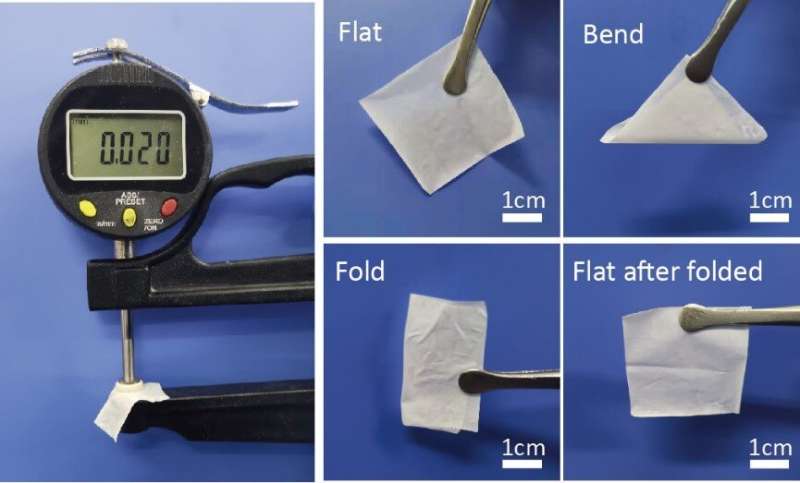Flexible solid electrolytes for all-solid-state lithium batteries

Garnet-type solid electrolytes are attracting great interest due to high ionic conductivity and excellent electrochemical stability against Li metal. However, the thick electrolyte layer and rigid nature as well as poor interfacial contact are huge obstacles for its application in all-solid-state lithium batteries. Currently, researchers in China provide a promising strategy toward realizing 20 μm-thick flexible Li6.4La3Zr1.4Ta0.6O12-based solid electrolyte for high-performance all-solid-state lithium batteries.
They published their work on July 4 in Energy Material Advances.
"The development of high-energy-density and safe all-solid-state lithium batteries employing solid electrolytes is imperative," said author Xiayin Yao, professor with the Ningbo Institute of Materials Technology and Engineering, Chinese Academy of Sciences (CAS). "The cell-level energy density of all-solid-state lithium batteries highly depends on the thickness of solid electrolytes and inorganic solid electrolyte thin film generally show thick and rigid nature."
Yao explained that polymer-in-ceramic garnet-based electrolytes can substantially overcome the above-mentioned challenges of garnet-type ceramic electrolytes.
"Polymer-in-ceramic garnet-based solid electrolyte can combine the merits of flexibility of polymer component and excellent electrochemical stability, mechanical modulus and thermal stability of inorganic electrolytes," Yao said. "However, due to the inferior strength of polymer component, polymer-in-ceramic garnet-based solid electrolyte generally show brittle fracture by reducing their thickness under high inorganic contents. Besides, traditional polymer-in-ceramic garnet-based solid electrolytes are often prepared by slurry casting method, which involves evaporation of massive noxious solvents and generally suffers sedimentation of agglomerated inorganic particles during preparation process."
Yao and his team developed a 20 μm-thick flexible Li6.4La3Zr1.4Ta0.6O12 (LLZTO)-based solid electrolyte with 90 wt% LLZTO content through solvent-free procedure. The resultant 20μm-thick LLZTO-based film exhibits ultrahigh ionic conductance of 41.21 mS at 30oC, excellent oxidation stability of 4.6 V, superior thermal stability and non-flammability. Moreover, the corresponding Li||Li symmetric cell can stable cycle for more than 2000 h with low overpotential at 0.1 mA cm-2 under 60oC.
"The feasibility of the LLZTO-based film in all-solid-state lithium metal battery has been verified. The assembled Li||LiFePO4 pouch cell with integrated electrolyte/cathode interface exhibits excellent rate performances and cycle performances with a capacity retention of 71.4 % from 153 mAh g-1 to 109.2 mAh g-1 at 0.1 C over 500 cycles under 60 oC," Yao said. "The presented ultrathin LLZTO-based film has great potential for practical applications in all-solid-state lithium batteries."
More information: Qingya Guo et al, 20 μm-Thick Li6.4La3Zr1.4Ta0.6O12-Based Flexible Solid Electrolytes for All-Solid-State Lithium Batteries, Energy Material Advances (2022). DOI: 10.34133/2022/9753506
Provided by Beijing Institute of Technology Press



















